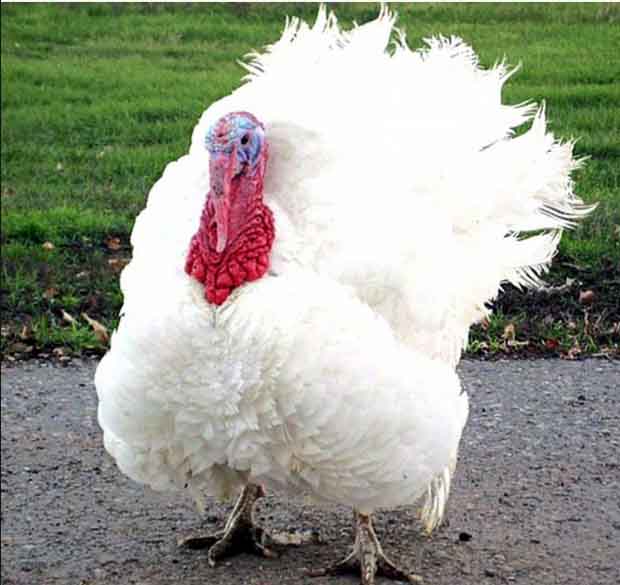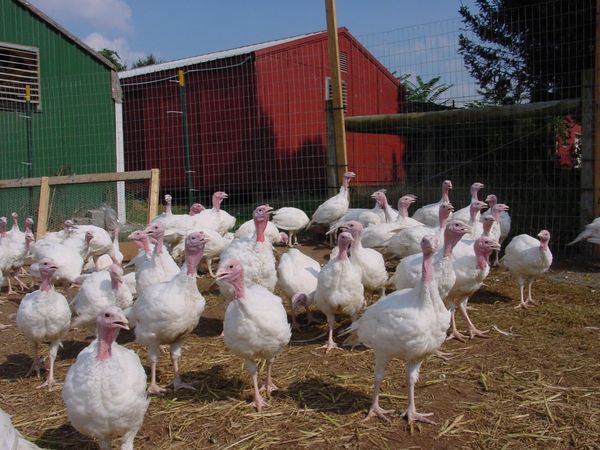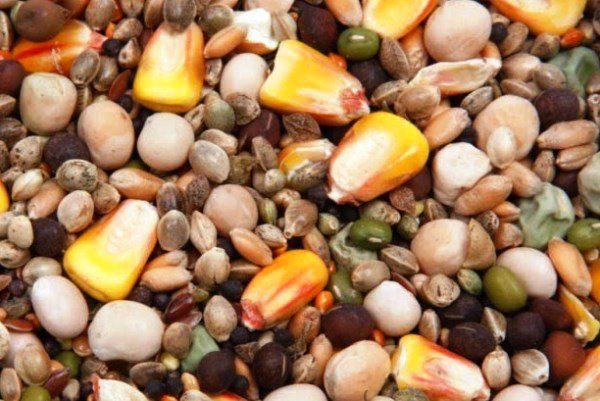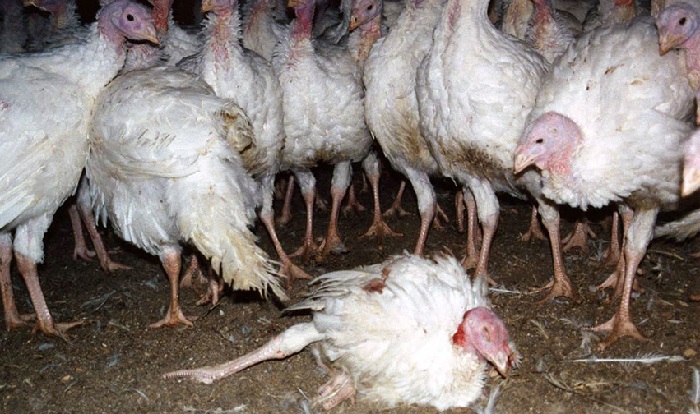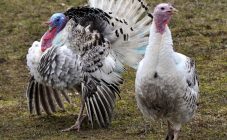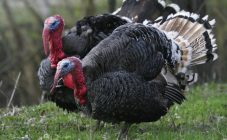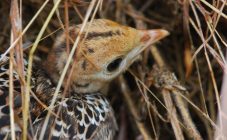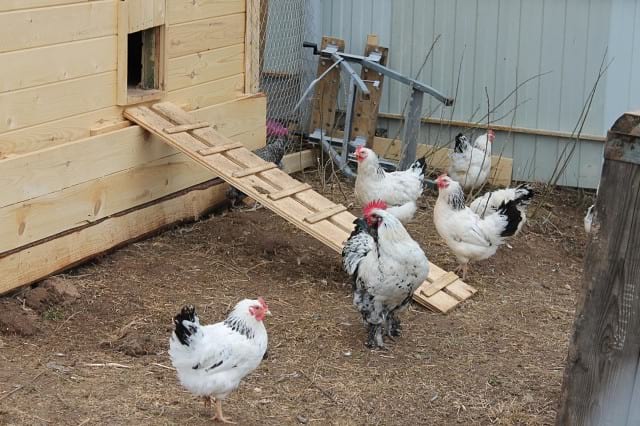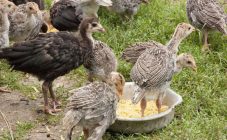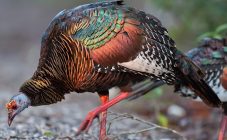Content:
Big 6 turkeys are the record holders for meat productivity. The breed was developed in the UK. The marketable weight of the bird is already reached by the time the turkey is 4 months old. As a rule, turkeys gain more than 4.4 kg by this time. Thanks to such productivity, Big 6 turkeys are in demand in many countries.
At six months, the turkeys finish forming and gain weight, accumulating body fat. The maximum weight of an adult male cross reaches 25-25.5 kg, and the weight of an adult female does not exceed 12 kg. The poultry carcass is light, without black stumps on the body, which allows you to maintain a good presentation. The meat is tender and juicy. Down of turkeys is in no less demand than meat, as it is unusually light and soft.
Description of the breed
Big 6 turkeys have a strong, heavy and massive body. Representatives of the breed are characterized by the following characteristics, which are indicated in the description:
- big wings;
- small head;
- powerful and strong enough paws;
- convex chest with pronounced muscularity;
- the location of a bright scarlet beard and earrings in the head area;
- snow-white plumage.
The characteristics of the breed say: to get a weight gain of 1000 g, you need to consume at least 2 kg of feed. The growth of a turkey also depends on the quality of the feed.
Breed productivity
Big 6 turkeys are raised for meat production. From each carcass, you can have almost 80% of the loin yield. In addition to meat, the owner of a turkey farm can count on the profit from the sale:
- feathers;
- fluff;
- turkey offal;
- eggs.
According to the reviews of the owners of Big 6 turkeys, the bird has a good level of egg production. Every year from one individual you can get 90-120 eggs, which are intended for food and for breeding poultry by growing in an incubator.
Features of breeding, keeping and caring for Big 6 turkeys at home
When breeding turkeys in industrial conditions, their maintenance is carried out in a specially equipped wide windowless poultry house. The lighting in the room is controlled and there is litter on the floor. Manufacturers often use cages for keeping. However, crosses can often be found in households. The conditions for keeping poultry in a home farm practically do not differ from industrial breeding. The main ones are:
- Providing walking throughout the day in summer. The bird should be in the house at night.
- The walls of the room should be made of bricks, and the floor should be filled with concrete. If there are windows in the barn, then they need to be sealed with bars so that the turkeys do not fly away.
- It is important to keep the house warm as the crosses cannot tolerate dampness and cold. To achieve high production results, turkeys should be bred in dry and warm rooms.
- The southern side of the house should be equipped with a manhole (its height from the floor is within 10-15 cm). The floor surface is covered with sawdust, straw or hay. It is necessary to systematically control the dryness of the litter.
- Given the unfriendliness of the birds, if there is a large herd, they should be kept in a room divided into several sections. Each sector should not contain more than 35 individuals.For each male, there may be 5-6 females. There are no more than 2 birds on each 1 m².
Perches for keeping turkeys
Turkeys need to equip perches with a height of within 95 cm. For their manufacture, thick, round bars should be prepared. Each individual will need 45-50 cm of perch. Also, before breeding birds, nests should be organized in the house. One is enough for 4-6 females. The recommended parameters of the nest are 60 × 60 × 60 cm.The height of the nut is within 12-15 cm.
The normal temperature in the room for turkeys is 16-17°C. In the cold season, it should not fall below 13°C. The barn should be equipped with artificial lighting, which will help to extend the daylight hours in winter.
There should be drinkers and feeders in specially designated areas for feeding. Open-air cages are built spacious, and from above they are covered with trellises or nets so that the birds do not fly away. But it is best to periodically trim the wings of the birds.
Turkey poults Big 6: growing at home
Turkey poults gain weight well. They need to be fed at exactly the right time. As food for young animals, special compound feed is suitable. Very small turkey poults are first taught to use chopped boiled eggs and wheat. This helps to stimulate the digestive process.
Only 3-4 days (the first week) of turkey poults' life can you add grated carrots and chopped greens to the eggs. After that, the following are gradually introduced:
- curdled milk;
- fish flour;
- cottage cheese.
An adult turkey should be fed either crushed or whole grains:
- corn;
- wheat;
- barley.
Grain is best added to the trough in the evening. The bird's daily diet should be based on:
- wheat bran;
- cake;
- fish meal;
- compound feed.
Dry food is added as it is eaten. In addition to feed, crosses need mineral fertilizing and clean water. If necessary, you can make your own nutritious food. To do this, you need to mix:
- corn (20%);
- wheat (33%);
- soybean meal (20%);
- fish meal (10%);
- protein-vitamin-mineral supplement (15%);
- chalk (0.2%);
- shell rock (0.4%);
- premix (1%).
Newborn Big 6 turkeys should be kept at a temperature of 30°C, which can be gradually decreased. Chicks of crosses are endowed with a good metabolism and generate a significant amount of heat. If the temperature in the room is very high, this will make the youngsters suffer. Turkeys cannot sweat, and through an open beak, the body's thermoregulation process is ineffective.
If desired, you can place the kids in a box, where there will be a constant temperature and round-the-clock lighting. As they grow older, the turkeys are moved to the poultry house, which needs preliminary disinfection and heating, as well as periodic ventilation, maintaining cleanliness and dryness.
The litter should be changed every 2-3 days. It is very important to control the condition of the walls of the room. Condensation is unacceptable when growing Big 6 turkeys.
Turkey diseases
Big 6 turkeys are prone to:
- Newcastle disease affecting young broilers and causing high flock mortality. The sick bird suffers from paralysis of the limbs, greenish-gray-yellow diarrhea. The goiter is filled with a mucous mass.Unfortunately, a serious illness cannot be treated, so it is important to carry out timely vaccinations to prevent it. The veterinarian will tell you which drug to buy for this.
- Respiratory mycoplasmosis, which causes eye swelling, coughing and hoarseness. The bird stops growing. You can cure the ailment with a variety of drugs that must be prescribed by a specialist.
- Aspergillotoxicosis. The disease affects poultry that eat poor quality food. Litter can also be the cause of the source of the disease. The turkey becomes inactive, sleeps a lot of time. The bird's breathing quickens, the need for food disappears. Stool disorder is observed and the bird dies in convulsions. As soon as the first symptoms appear, the litter should be changed, the diet should be changed to good quality compound feed. It is very important to disinfect and add fermented milk products to the poultry menu.
- Histomoniasis, which affects the liver and causes a disease of the cecum in chicks. As a rule, the cause of the disease is poor-quality disinfection in the room where the turkeys are kept. The bird ceases to be interested in food, suffers from yellow-green diarrhea, weakens and grows thin. The turkey feathers become disheveled and unkempt. You can cure the disease with the help of furazolidone and osarsol. In addition, deworming with piperazine will be required.
Big 6 turkeys are quite easy to keep, but before starting crosses, it is important to organize a spacious room for them. In addition, after the acquisition of young animals, it is worth providing them with high-quality nutrition and keeping the poultry house clean. Feeders, drinkers and trays must always be clean. This is the only way to grow crosses and get tender and weighty meat.
